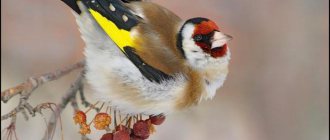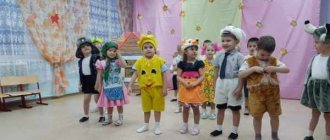Summary of a lesson in the middle group on the topic “Insects”
Brief description of the document:
Summary of a lesson in the middle group on the topic “Insects” Program content: Educational objectives: Expand children’s understanding of the life of insects; clarify ideas about the benefits of insects. Activate children's vocabulary (abdomen, antennae). To develop the ability to name the characteristic features of appearance. Developmental tasks: Develop coherent speech and logical thinking. Educational objectives: To cultivate interest, love for nature and respect for it. Materials: Audio recording of nature sounds; pictures of insects. Colored pencils, sheets of paper depicting parts of an insect. Progress of the lesson. - Children, tell me, what time of year is it now? - Spring. It's already the end of spring. Very warm. At this time, everything comes to life, awakens from hibernation. An audio recording of the sounds of nature is played. - Children, what do you think these sounds are? - Bees, bumblebees, beetles are buzzing, grasshoppers are chirping... - How to call them in one word? - Insects. - Look at what insects there are (pictures of insects appear on the screen). Poems about insects. The beetle swayed on a blade of grass, its wings smooth on its back. - I know everyone in the meadow, I can introduce you! Here the grasshopper jumped, splashed all the dewdrops, is barely visible in the thickets - He is green like grass. Here are two butterflies flying. They want to tell you that yesterday there were two caterpillars living in the grass. Here is a hard worker ant - Stronger and healthier for everyone! He is a builder and an entertainer, He is building an anthill in the thicket. Next to the river there is a dragonfly: Fidget, fidget. Like a cheerful helicopter, it takes flight. Good-naturedly hiding her sting, a bee was buzzing on a flower, dressed in a warm fur coat. She's not hot, even though it's summer. Like a ladybug, the wings are colorful new things. Smooth, satiny, bright and red. A conversation about the characteristics of insects. All insects have 6 legs, a head, an abdomen, antennae on the head, some insects have wings (parts of the body of insects are shown in the picture). Finger game “Butterfly” In the morning the sun will shine - a butterfly takes off from a flower. If it flutters around, it gets tired, when it rests, it starts spinning again. We all love butterflies very much and admire their beauty. Butterflies live where it is warm and there is food for them. They feed on flower nectar, plant and fruit juices. The names of some of the butterflies are related to what their caterpillars feed on. For example, Cabbage caterpillars feed on cabbage leaves, and Urticaria caterpillars feed on nettles. Different types of butterflies differ in color and size. Mosquitoes, like other insects, make buzzing sounds. The buzzing of a mosquito is the flapping of its wings several hundred times per second. The outdoor game “One, two, three, the mosquitoes have arrived.” We choose two children with a counting rhyme who will be “playing guys”. Mosquito, mosquito, mosquito. Bite, bite near the ear. Mosquito, don’t bite the mosquito. Run, get away quickly! They stand in this part of the hall, and the rest of the players - “mosquitoes” - run around the hall in all directions. The “playing guys” pronounce the words: One, two, three, mosquitoes have arrived. The mosquitoes began to squeak and did not allow us to play. One, two, three, I'm tired of mosquitoes. Tired of mosquitoes. Catch the mosquito quickly! With the end of the words, the “playing guys” begin to run with catching and dodging. The one who is tainted is eliminated from the game. Everyone knows ants. These are very hardworking insects. Ants work hard for their large ant family. Their home is an anthill. It's warm there and there's enough food to last all winter. Ants feed on other insects and the juices of plant fruits. There are many species of ants that differ in color, size and habitat. Finger game "Bug". The bug lies on its back and buzzes, buzzes, buzzes: “Help me bug, I can’t get up on my legs!” — He shouts to passers-by. We will help him. The beetle moves its mustache and says “thank you” to us. There are many types of beetles. They live in almost all countries and differ from each other in appearance and lifestyle. Beetles feed on plants or other insects. Tell me what beetles you saw, do you know? Physical education minute. We raise our shoulders. Jump, grasshoppers. Jump - jump, jump - jump. We sit down, eat some grass, and listen to the silence. Hush, hush, high Jump on your toes easily. Hiding in thick grass, this insect makes itself known with a peculiar sound. The grasshopper has a special vein on its wings, which it moves like a bow and makes chirping sounds. Grasshoppers are great jumpers. They feed exclusively on animal food. Finger game “Bees” Ay – yay – yay, oh – oh – oh – There’s a whole swarm of bees in the hive! The bees began to fly out - One, two, three, four, five. “F – f – f,” they buzz overhead. Let's run home quickly! Do you know where honey comes from? It's made by bees. They live in houses called hives and work constantly. The bee has a bright outfit - a yellow coat with black stripes. Why do people protect bees and breed them? Physical education The dragonfly flies like a pea's eyes. Down - up, back - forward Like a transparent plane. Left - right, back - forward. The dragonfly is a formidable predator in the insect world. This is the fastest flying insect. She lives near the water. And it feeds on small insects, such as mosquitoes. Finger game “Ladybug” A bug is crawling along a flower. She's wearing a red shirt. Little baby with polka dots on her back. This small, cute bug is a real predator. They eat hordes of aphids that are harmful to plants, thereby helping people in their gardens. Game "Who's Missing?" On the board in front of the children are pictures of all the insects. First, children look carefully at the pictures. Then they close their eyes. And at this time the teacher removes one picture. Children open their eyes and guess who is missing. Insects are part of nature. If they disappear from our planet, then plants, animals, and birds will die. All of them cannot exist without each other. They need to be protected and protected, but under no circumstances should they be killed. Look, there are drawings in front of you. What's wrong with them? What did the artist forget to finish drawing? Correct the mistakes. (Children fill in the missing parts of the insects and color them).
Educational conversation “What kinds of insects are there?”
Educational conversation in the senior group
“What kinds of insects are there?”
Target:
systematize children’s ideas about the diversity of insects; consolidate knowledge about the general characteristics of insects; learn to establish connections between the features of the external structure and the method of movement, between appearance and the method of protection from enemies; clarify the habitats of insects; develop children’s cognitive and creative abilities, logical and spatial thinking, speech, fine motor skills; cultivate interest in insects and respect for them.
Developmental environment:
pictures and illustrations depicting insects, a visual aid “Insects”, an audio recording “The Dance of the Butterflies” by M. Krasev; book about nature “Miracle in the palm of your hand”, graphic model of an insect, plasticine.
PROGRESS OF THE CONVERSATION
Before the start of the lesson, children look at the visual aid “Insects”, flashcards and illustrations with insects.
— Today we are going to visit our six-legged friends. Who do you think we will talk about? (about insects)
- Right! Guys, by what main signs do we recognize insects? ( All insects have six legs. The body consists of three parts: head, middle part and abdomen)
-What else do insects have? (There are two antennae on the head, some have a proboscis and wings)
— Why do insects need a proboscis and wings?
(They feed with the help of a proboscis; wings are needed to move)
- Right! Many insects fly. Some fly very fast: a dragonfly, for example, can reach speeds of up to 40 km per hour. Other insects walk and jump. Can you name me such insects?
(Beetles that have no wings walk. A grasshopper jumps)
- Indeed, the grasshopper is a good jumper. He can jump a distance of 20 times his body length. And if he releases his wings, he will fly away, gliding, even further.
— Guys, what do insects eat? (Flower nectar, leaves)
— All insects feed differently. Some eat plants. These include grasshoppers. With their jaws, like nippers, they bite off pieces of grass. Butterflies and moths feed on flower nectar using a special proboscis. It spins like a squeaky toy. When the insect is not eating, the proboscis curls into a spiral. The mosquito feeds on plant sap and sweet nectar. And his female feeds on blood. She pierces the skin with her proboscis, like a syringe, and sucks blood. There are also predators among insects. This is a dragonfly - it feeds on flies and mosquitoes. moths. Some ants eat grass seeds, midges, and worms. And the ladybug feeds on the smallest living creatures - aphids. Guys, why are ladybugs called that (the story is accompanied by a demonstration of illustrations)
- Because they secrete “milk”, but not white one. and poisonous yellow, which appears on the bends of the paws in times of danger. In fact, it is blood, acrid and smelling unpleasant. Therefore, neither birds nor lizards eat cows. They can also be called migratory beetles. It turns out that at the end of summer and autumn, cows fly for the winter. And in the spring and early summer they return. But not all cows fly away. Many of them, like other beetles, hide in cracks, in the crevices of tree bark, and in last year’s grass. Therefore, if you burn last year’s grass, you can also burn insects. They must be treated with care and the grass in gardens and orchards must not be burned.
PHYSMINUTE
Children move smoothly to the music “Butterfly Dance”.
D/I “WHO LIVES WHERE”.
Cards with images of insects are laid out in front of you. You must take a card and place it on the picture that corresponds to the habitat of this insect. Children lay out the cards and comment on their choices.
— How does coloring help insects?
Indeed, the color of insects often depends on their habitat. This helps them escape from enemies. Some, thanks to coloring, become invisible. So the thorn bug looks like a thorn growing on a branch. Some butterflies, when sitting quietly, resemble a leaf. Some are invisible on tree bark. The flower mantis is similar to the flower on which it sits. (the story is accompanied by the display of corresponding illustrations) Other insects have such bright colors that enemies do not risk approaching them. Why do you think? (children's answers)
— Insects colored in red-black, yellow and black tones are usually unpleasant to the taste, and birds do not touch them. There are insects, the bombardier beetle, which release a stream of caustic chemicals with a pungent odor at the moment of danger. While the enemy comes to his senses, the beetle runs away.
— Guys, are there many or few insects on earth? (children's answers) What would happen if there were no insects? (children's answers)
Let's play the game "GOOD - BAD".
Are many different insects good or bad? (children's answers)
What else is good? (interesting to watch, beautiful, food for others, etc.)
What is wrong? (can sting, interfere with rest, etc.)
RESULT.
Who did we talk about today? What interesting things did you learn? Children choose to sculpt an insect.





